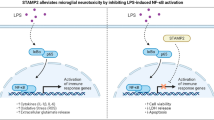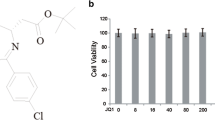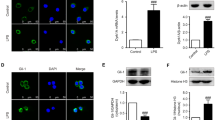Abstract
In various neuronal diseases, the activation of microglia contributes to the production of excessive neurotoxic factors, such as pro-inflammatory mediators. In particular, the overproduction of pro-inflammatory cytokines and nitric oxide (NO) has critical effects on the development of neurodegenerative diseases and gliomas in the brain. Recent studies have suggested that isocitrate dehydrogenase 2 (IDH2) plays a key role in inducing gliomas and neurodegeneration. IDH2 dysfunction has been linked to various cancers and neurodegenerative diseases associated with uncontrolled inflammatory responses, such as the excessive generation of pro-inflammatory cytokines. In this study, we demonstrate that IDH2 contributes to the regulation of pro-inflammatory mediators in microglia. The downregulation of IDH2 decreased the lipopolysaccharide (LPS)-induced pro-inflammatory response in BV-2 and primary microglial cells. Furthermore, IDH2 deficiency downregulated pro-inflammatory mediators via modulation of the ERK and NF-κB pathways. These results indicate that IDH2 is a potential target for the regulation of pro-inflammatory responses in LPS-activated microglial cells. Our findings also provide a basis for the development of new therapies for pro-inflammatory responses in dysfunction-associated neuronal diseases.




Similar content being viewed by others
References
Smolkova, K., and P. Jezek. 2012. The role of mitochondrial NADPH-dependent isocitrate dehydrogenase in cancer cells. International Journal of Cell Biology 2012: 273947.
Yang, E.S., J.H. Lee, and J.W. Park. 2008. Ethanol induces peroxynitrite-mediated toxicity through inactivation of NADP+-dependent isocitrate dehydrogenase and superoxide dismutase. Biochimie 90: 1316–1324.
Megova, M., J. Drabek, V. Koudelakova, R. Trojanec, O. Kalita, and M. Hajduch. 2014. Isocitrate dehydrogenase 1 and 2 mutations in gliomas. Journal of Neuroscience Research 92: 1611–1620.
Chen, C., Y. Liu, C. Lu, J.R. Cross, J.P.t. Morris, A.S. Shroff, P.S. Ward, J.E. Bradner, C. Thompson, and S.W. Lowe. 2013. Cancer-associated IDH2 mutants drive an acute myeloid leukemia that is susceptible to Brd4 inhibition. Genes & Development 27: 1974–1985.
Wang, P.F., H.W. Song, H.Q. Cai, L.W. Kong, K. Yao, T. Jiang, S.W. Li, and C.X. Yan. 2017. Preoperative inflammation markers and IDH mutation status predict glioblastoma patient survival. Oncotarget 8: 50117–50123.
Zhang, J.M., and J. An. 2007. Cytokines, inflammation, and pain. International Anesthesiology Clinics 45: 27–37.
Shih, R.H., C.Y. Wang, and C.M. Yang. 2015. NF-kappaB signaling pathways in neurological inflammation: a mini review. Frontiers in Molecular Neuroscience 8: 77.
Corps, K.N., T.L. Roth, and D.B. McGavern. 2015. Inflammation and neuroprotection in traumatic brain injury. JAMA Neurology 72 (3): 355–362.
Xanthos, D.N., and J. Sandkuhler. 2014. Neurogenic neuroinflammation: inflammatory CNS reactions in response to neuronal activity. Nature Reviews Neuroscience 15: 43–53.
Graeber, M.B., W. Li, and M.L. Rodriguez. 2011. Role of microglia in CNS inflammation. FEBS Letters 585: 3798–3805.
Stoll, G., S. Jander, and M. Schroeter. 2000. Cytokines in CNS disorders: neurotoxicity versus neuroprotection. Journal of Neural Transmission. Supplementum 59: 81–89.
W.Y. Wang, M.S. Tan, J.T. Yu, L. Tan. 2015. Role of pro-inflammatory cytokines released from microglia in Alzheimer’s disease. Annals of Translational Medicine 3: 136.
Hambardzumyan, D., D.H. Gutmann, and H. Kettenmann. 2016. The role of microglia and macrophages in glioma maintenance and progression. Nature Neuroscience 19: 20–27.
Santa-Cecilia, F.V., B. Socias, M.O. Ouidja, J.E. Sepulveda-Diaz, L. Acuna, R.L. Silva, P.P. Michel, E. Del-Bel, T.M. Cunha, and R. Raisman-Vozari. 2016. Doxycycline suppresses microglial activation by inhibiting the p38 MAPK and NF-kB signaling pathways. Neurotoxicity Research 29: 447–459.
Surh, Y.J., H.K. Na, J.Y. Lee, and Y.S. Keum. 2001. Molecular mechanisms underlying anti-tumor promoting activities of heat-processed Panax ginseng C.A. Meyer. Journal of Korean Medical Science 16 (Suppl): S38–S41.
Kim, S., S.Y. Kim, H.J. Ku, Y.H. Jeon, H.W. Lee, J. Lee, T.K. Kwon, K.M. Park, and J.W. Park. 2014. Suppression of tumorigenesis in mitochondrial NADP(+)-dependent isocitrate dehydrogenase knock-out mice. Biochemical and Biophysical Research Communications 1842: 135–143.
Brewer, G.J., and J.R. Torricelli. 2007. Isolation and culture of adult neurons and neurospheres. Nature Protocols 2: 1490–1498.
Saura, J., J.M. Tusell, and J. Serratosa. 2003. High-yield isolation of murine microglia by mild trypsinization. Glia 44: 183–189.
Kim, T.S., H.S. Choi, B.Y. Ryu, G.T. Gang, S.U. Kim, D.B. Koo, J.M. Kim, J.H. Han, C.K. Park, S. Her, and D.S. Lee. 2010. Real-time in vivo bioluminescence imaging of lentiviral vector-mediated gene transfer in mouse testis. Theriogenology 73: 129–138.
Block, M.L., L. Zecca, and J.S. Hong. 2007. Microglia-mediated neurotoxicity: uncovering the molecular mechanisms. Nature Reviews Neuroscience 8: 57–69.
Perry, V.H., J.A. Nicoll, and C. Holmes. 2010. Microglia in neurodegenerative disease. Nature Reviews Neurology 6: 193–201.
Vijitruth, R., M. Liu, D.Y. Choi, X.V. Nguyen, R.L. Hunter, and G. Bing. 2006. Cyclooxygenase-2 mediates microglial activation and secondary dopaminergic cell death in the mouse MPTP model of Parkinson’s disease. Journal of Neuroinflammation 3: 6.
Dawson, V.L., and T.M. Dawson. 1996. Nitric oxide neurotoxicity. Journal of Chemical Neuroanatomy 10: 179–190.
Strauss, K.I. 2008. Antiinflammatory and neuroprotective actions of COX2 inhibitors in the injured brain. Brain, Behavior, and Immunity 22: 285–298.
Kim, S.H., C.J. Smith, and L.J. Van Eldik. 2004. Importance of MAPK pathways for microglial pro-inflammatory cytokine IL-1 beta production. Neurobiology of Aging 25: 431–439.
Chen, W.W., X. Zhang, and W.J. Huang. 2016. Role of neuroinflammation in neurodegenerative diseases (review). Molecular Medicine Reports 13: 3391–3396.
Rock, R.B., G. Gekker, S. Hu, W.S. Sheng, M. Cheeran, J.R. Lokensgard, and P.K. Peterson. 2004. Role of microglia in central nervous system infections. Clinical Microbiology Reviews 17: 942–964.
Baeuerle, P.A., and D. Baltimore. 1996. NF-kappa B: ten years after. Cell 87: 13–20.
Mattson, M.P., and S. Camandola. 2001. NF-kappaB in neuronal plasticity and neurodegenerative disorders. Journal of Clinical Investigation 107: 247–254.
Kaminska, B. 2005. MAPK signalling pathways as molecular targets for anti-inflammatory therapy—from molecular mechanisms to therapeutic benefits. Biochimica et Biophysica Acta 1754: 253–262.
Cohen, A.L., S.L. Holmen, and H. Colman. 2013. IDH1 and IDH2 mutations in gliomas. Current Neurology and Neuroscience Reports 13: 345.
Chanmee, T., P. Ontong, K. Konno, and N. Itano. 2014. Tumor-associated macrophages as major players in the tumor microenvironment. Cancers (Basel) 6: 1670–1690.
Ku, H.J., Y. Ahn, J.H. Lee, K.M. Park, and J.W. Park. 2015. IDH2 deficiency promotes mitochondrial dysfunction and cardiac hypertrophy in mice. Free Radical Biology & Medicine 80: 84–92.
Park, J., J.S. Min, B. Kim, U.B. Chae, J.W. Yun, M.S. Choi, I.K. Kong, K.T. Chang, and D.S. Lee. 2015. Mitochondrial ROS govern the LPS-induced pro-inflammatory response in microglia cells by regulating MAPK and NF-kappa B pathways. Neuroscience Letters 584: 191–196.
Turner, M.D., B. Nedjai, T. Hurst, and D.J. Pennington. 2014. Cytokines and chemokines: at the crossroads of cell signalling and inflammatory disease. Biochimica et Biophysica Acta 1843: 2563–2582.
Funding
This research was supported by grants from the National Research Foundation of Korea, funded by the government of Republic of Korea (NRF-2015R1A4A1042271, NRF-2017R1A2B4008176, NRF-2017R1A5A2015391).
Author information
Authors and Affiliations
Corresponding author
Ethics declarations
All animal experiments performed in accordance with the guidelines of the Animal Care Committee of Kyungpook National University.
Rights and permissions
About this article
Cite this article
Chae, U., Kim, H.S., Kim, KM. et al. IDH2 Deficiency in Microglia Decreases the Pro-inflammatory Response via the ERK and NF-κB Pathways. Inflammation 41, 1965–1973 (2018). https://doi.org/10.1007/s10753-018-0840-5
Published:
Issue Date:
DOI: https://doi.org/10.1007/s10753-018-0840-5




